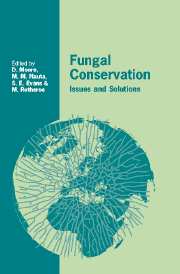Book contents
- Frontmatter
- Contents
- List of contributors
- Preface
- 1 Fungal conservation issues: recognising the problem, finding solutions
- 2 Current trends and perspectives for the global conservation of fungi
- 3 Conservation and management of forest fungi in the Pacific Northwestern United States: an integrated ecosystem approach
- 4 The future of fungi in Europe: threats, conservation and management
- 5 Fungi as indicators of primeval and old-growth forests deserving protection
- 6 Recognising and managing mycologically valuable sites in The Netherlands
- 7 Threats to hypogeous fungi
- 8 Wild mushrooms and rural economies
- 9 Threats to biodiversity caused by traditional mushroom cultivation technology in China
- 10 A preliminary survey of waxcap grassland indicator species in South Wales
- 11 Grasslands in the coastal dunes: the effect of nature management on the mycota
- 12 The conservation of fungi on reserves managed by the Royal Society for the Protection of Birds (RSPB)
- 13 Strategies for conservation of fungi in the Madonie Park, North Sicily
- 14 Fungal conservation in Ukraine
- 15 The threatened and near-threatened Aphyllophorales of Finland
- 16 Fungal conservation in Cuba
- 17 Microfungus diversity and the conservation agenda in Kenya
- 18 Fungi and the UK Biodiversity Action Plan: the process explained
- 19 The Scottish Wild Mushroom Forum
- 20 The contribution of national mycological societies: establishing a British Mycological Society policy
- 21 The contribution of national mycological societies: the Dutch Mycological Society and its Committee for Fungi and Nature Conservation
- 22 Fungal conservation in the 21st century: optimism and pessimism for the future
- Index
5 - Fungi as indicators of primeval and old-growth forests deserving protection
Published online by Cambridge University Press: 13 October 2009
- Frontmatter
- Contents
- List of contributors
- Preface
- 1 Fungal conservation issues: recognising the problem, finding solutions
- 2 Current trends and perspectives for the global conservation of fungi
- 3 Conservation and management of forest fungi in the Pacific Northwestern United States: an integrated ecosystem approach
- 4 The future of fungi in Europe: threats, conservation and management
- 5 Fungi as indicators of primeval and old-growth forests deserving protection
- 6 Recognising and managing mycologically valuable sites in The Netherlands
- 7 Threats to hypogeous fungi
- 8 Wild mushrooms and rural economies
- 9 Threats to biodiversity caused by traditional mushroom cultivation technology in China
- 10 A preliminary survey of waxcap grassland indicator species in South Wales
- 11 Grasslands in the coastal dunes: the effect of nature management on the mycota
- 12 The conservation of fungi on reserves managed by the Royal Society for the Protection of Birds (RSPB)
- 13 Strategies for conservation of fungi in the Madonie Park, North Sicily
- 14 Fungal conservation in Ukraine
- 15 The threatened and near-threatened Aphyllophorales of Finland
- 16 Fungal conservation in Cuba
- 17 Microfungus diversity and the conservation agenda in Kenya
- 18 Fungi and the UK Biodiversity Action Plan: the process explained
- 19 The Scottish Wild Mushroom Forum
- 20 The contribution of national mycological societies: establishing a British Mycological Society policy
- 21 The contribution of national mycological societies: the Dutch Mycological Society and its Committee for Fungi and Nature Conservation
- 22 Fungal conservation in the 21st century: optimism and pessimism for the future
- Index
Summary
Introduction
Conservation of fungi, particularly populations of rare and endangered fungal species, is only possible when their habitats are protected. Consequently, efforts in fungal conservation will be successful only when cooperation with other environmentalists interested in nature conservation is established. Joint, well-motivated proposals to create new protected areas or to regulate a conservation regime in existing reserves will then accepted more easily than otherwise. The role of mycologists is not only to study the mycota of nature reserves, but also to take the initiative in creating new reserves.
Protection of primeval and old-growth forests
Primeval forests are very rare in Europe. Some kind of forest management has been practised almost everywhere except in those forest stands that are low in productivity and poor in species composition growing on oligotrophic Sphagnum bogs in northern areas. Seminatural old-growth forests with minimal human impact have survived mainly in nature reserves.
In Estonia, of the 138 hemerophobic vascular plant species found, 90 are growing only or mainly in forests (Kukk, 1999; Trass, Vellak & Ingerpuu, 1999); there are 79 hemerophobic bryophytes and 88 lichens in the Estonian forests. In the boreal zone, old unmanaged forest is the main refugium for rare and endangered species, including fungi. Protection of different forest site types is effective for conservation of species as well as of communities.
In the European Union, the main target of nature protection has been different groups of higher organisms (primarily birds) and a few selected habitat types (wetlands, Mediterranean communities).
- Type
- Chapter
- Information
- Fungal ConservationIssues and Solutions, pp. 81 - 88Publisher: Cambridge University PressPrint publication year: 2001
- 13
- Cited by



